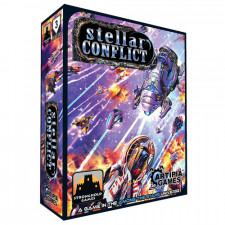Stellar Conflict Review
on Jul 13, 2016
I had no idea that Stellar Conflict, a new game set in the Among the Stars universe, is a reprint of a fairly obscure Cheapass Games design published 13 years ago as Light Speed. Back when that little five dollar firecracker came out, I played it quite a lot as a micro-filler with the folks I was gaming with at the time so I was glad to see this fun, simple, and lightning fast little space battler turn up again unexpectedly. There are a couple of positive changes from the original James Earnest/Tom Jolly design and even though this version of the game retails at literally five times the original’s asking price it still manages to prove its mettle among the more recent real-time games that have followed in its wake.
The gameplay concept is that each player represents the fleet of one of four factions- this time out, they have special abilities keyed to various Among the Stars races. Each has a deck of ship cards of varying classes and sizes with different ratings of hull and initiative. You can play a points-based game if you’d like to put everyone on an equal level in terms of fleet value. There are no turns, you simply flip the top card of your deck over and put it anywhere on the table. You can push it around and turn it, but once you remove your fingers from it, the card is locked in place.
Each card has lasers projecting out from the ship as well as shields around one or more edges. When the round is over (either based on a timer or on the original rules where it ends when someone plays their last card), everything starts shooting. Ships are rated for initiative, so the lower-rated (faster) ships shoot first. You follow the laser beams on the cards and stretch out rubber bands to check to see if you hit anything. There are three strengths of lasers that deal from one to three damage. Hitting a ship (friendly fire counts) damages or destroys a ship unless you hit its shields. There are also cargo ships, and if you hit one you steal cargo from it for points. There are also optional asteroid cards you can put in the mix as well.
The resolution takes longer than actually playing the cards, but this phase is also where a lot of the fun and drama occur. You’ll start out with a table full of ships, some will inevitably wind up in terrible positions, getting blown away before they get in their shot. Other times you’ll have a ship wind up in exactly the right spot to completely decimate your opponents. You might pull of a crazy long shot across the table that no one saw coming. Or you might wind up whiffing with just about everything. Regardless of what happens, I can guarantee you that any fun-loving group will be reshuffling and playing it again- and the revenge rounds might run for another 20 or 30 minutes!
Obviously, this is not a serious game. It’s frivolous and silly with pretty much nothing to offer to gamers looking for intensely deep, complex design work. It’s a pew-pew blast ‘em up where the measure of success is not in terms of the VP count at the end, but in how many times you laughed or smiled. The new illustrations are fine, the new powers work well and offer variety that wasn’t present in the original game, and overall this is a great edition of a forgotten gem.

 Customer Support
Customer Support  Subscribe
Subscribe 




 Account
Account  Wishlist
Wishlist 

